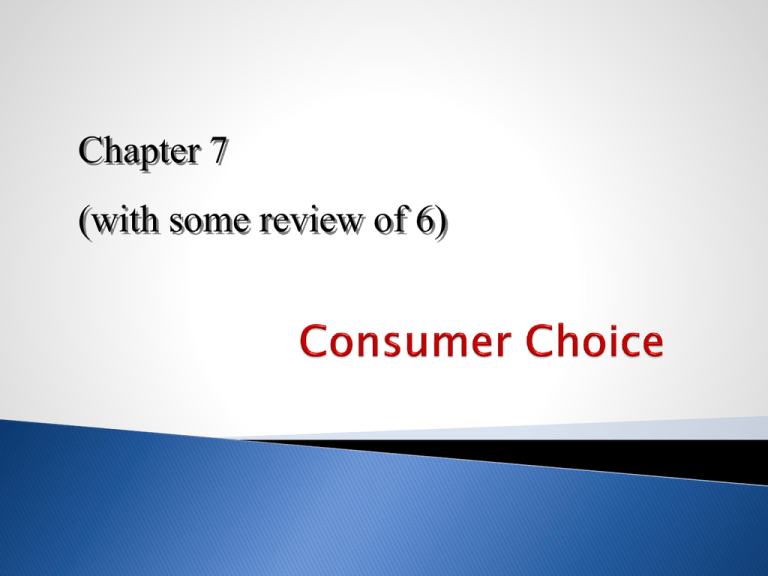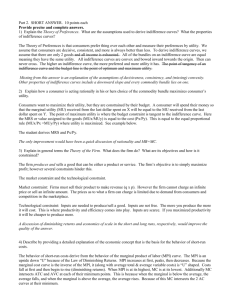
Chapter 7
(with some review of 6)
Utility is a measure of the satisfaction
received from possessing or consuming
goods and services.
2
Economists assume that:
◦ Tastes and preferences are fixed and given, and
play a large role in decision making.
◦ Consumers make choices that give them the
greatest utility—they maximize utility.
3
Marginal utility: the extra utility derived
from consuming one more unit of a good
or service.
change in total utility
marginal utility
change in quantity
4
Principle of diminishing marginal utility: the
more of a good that one obtains in a
specific period of time, the less the
additional utility derived from an additional
unit of the good.
◦ As you consume more and more of something,
the satisfaction with each unit declines.
Disutility: dissatisfaction
5
Chapter 21 - Consumer Choice
6
Hours of Util of Each Hour
Listening (marginal utility)
Total
Utility
1
200
200
2
98
298
3
50
348
4
10
358
5
0
358
6
-70
288
7
-200
88
7
Utility diminishes with increasing quantities –
especially in a limited time—the shorter the
time period, the more quickly marginal utility
diminishes.
“All You Can Eat”—restaurants with this policy
assume that you will stop eating when your
marginal utility falls to zero.
8
Consumers are not identical—the rate at
which marginal utility diminishes depends on
individual tastes and preferences, and so
differs across consumers.
9
Each consumer allocates a specific
budget to expenditure, and then
allocates the expenditure to maximize
utility.
10
When you cannot increase
utility by spending more
on one good and less on
another within a given
budget, you are said to be
in a state of consumer
equilibrium.
The conditions for
consumer equilibrium are
expressed by the formula
on the right
MU(A) =
P(A)
MU(B)
P(B)
Units
1
2
3
4
5
6
7
8
9
Pizza
Utils
22
18
14
9
6
2
1
0
-4
Hot dogs
Utils
15
13
10
8
6
4
2
1
0
Notes:
Budget: $10
First Prices $1 each
Adjust Pizza to $2
Derive 2 points on D for Pizza
12
Equimarginal principle: To maximize utility,
consumers allocate their incomes among goods
so as to equate the marginal utilities per dollar
(MU/P) of the expenditure on the last unit of
each good purchased. This is also referred to as
the consumer equilibrium.
MUCD MUgas MUmovie
MU X
PCD
Pgas
Pmovie
PX
13
Consumers allocate their income among
goods and services in order to maximize
utility according to the equimarginal
principle.
A change in the price of any good disturbs
the consumer’s equilibrium—the ratio of
MU to P on the last unit of each good will
no longer be equal.
14
The consumer must reallocate income
across goods
With income fixed, if the price of one good
rises, the consumer is able to buy fewer
goods and services, causing the consumer
to demand less.
◦ This shows as a decrease in quantity demanded
for the good whose price rose
◦ It shows as a decrease in demand for other goods
15
• An income-compensated price change is an
imaginary exercise:
• assume that the price of one good or service
changes
• Imagine that the consumer’s income is adjusted
so that he or she has just enough to purchase
the original combination of goods and services at
the new set of prices.
• Ask: What changes in purchases would the
consumer make in their consumption to reflect
the changing RELATIVE PRICES of the goods?
• The substitution effect is the change in
a consumer’s consumption of a good in
response to an income-compensated
price change.
• Imagine the same price change as before, but with no
adjustment in income.
• Can the consumer make all the same purchases as
before?
• The changing prices = a change in purchasing power,
or in effective INCOME.
• What adjustments to purchases of that good whose
price changed?
• That change is called: The income effect of a price
change is the change in consumption of a good
resulting from the implicit change in income because
of a price change.
When the price of one good falls while
everything else is constant, two things
occur:
1. Other goods become relatively more expensive.
So consumers buy more of the less expensive
good and less of the more expensive goods.
This is called the substitution effect.
2. The consumer can buy more total goods with
the same income. Therefore they buy more of
the now lower priced good. This is called the
income effect.
19
Normal Good
20
Inferior Good
21
Indifference Curves
Indifference analysis is an alternative way
of explaining consumer choice that does
not require an explicit discussion of utility.
Indifferent: the consumer has no
preference among the choices.
Indifference curve: a curve showing all the
combinations of two goods (or classes of
goods) that the consumer is indifferent
among.
22
Indifference Curve
All points along the
indifference curve
represent combinations
that are equally satisfying
23
Indifference Curves: Shape
A common shape for an indifference
curve is downward sloping.
–
For the consumer to be indifferent to
the bundle of goods chosen, as less of
one good is consumed, more of another
must be consumed.
24
Indifference Curves: Shape (2)
The indifference curves are not likely to be
vertical, horizontal, or upward sloping.
–
–
–
A vertical or horizontal indifference curve holds the
quantity of one of the goods constant, implying that the
consumer is indifferent to getting more of one good
without giving up any of the other good.
An upward-sloping curve would mean that the
consumer is indifferent between a combination of goods
that provides less of everything and another that
provides more of everything.
Rational consumers usually prefer more to less.
25
Indifference Curve Shapes
Improbable or impossible shapes:
26
Indifference Curves: Slope
The slope or steepness of indifference
curves is determined by consumer
preferences.
–
–
It reflects the amount of one good that a consumer
must give up to get an additional unit of the other good
while remaining equally satisfied.
This relationship changes according to diminishing
marginal utility—the more a consumer has of a good,
the less the consumer values an additional value of
that good. This is shown by an indifference curve that
bows in toward the origin.
27
Marginal Rate of Substitution
The slope of an
indifference curve
represents the rate at which
a consumer would be
willing to exchange one
good for another – with
indifference
That ratio is called the
Marginal Rate of
Substitution
28
Indifference Curves:
No Crossing Allowed!
Indifference curves cannot cross.
If the curves crossed, it would mean that the
same bundle of goods would offer two different
levels of satisfaction at the same time.
If we allow that the consumer is indifferent to all
points on both curves, then the consumer must
not prefer more to less.
There is no way to sort this out. The consumer
could not do this and remain a rational consumer.
29
Indifference
Curves Cannot
Cross!
30
Indifference Map
An indifference map is a complete set of
indifference curves.
It indicates the consumer’s preferences
among all combinations of goods and
services.
The farther from the origin the indifference
curve is, the more the combinations of
goods along that curve are preferred.
31
Indifference
Map
32
Budget Constraint
The indifference map only reveals the
ordering of consumer preferences among
bundles of goods. It tells us what the
consumer is willing to buy.
It does not tell us what the consumer is
able to buy. It does not tell us anything
about the consumer’s buying power.
The budget line shows all the
combinations of goods that can be
purchased with a given level of income.
33
The
Budget Line
34
The Budget Line
35
Consumer Equilibrium
The indifference map in combination with the
budget line allows us to determine the one
combination of goods and services that the
consumer most wants and is able to
purchase. This is the consumer equilibrium.
The demand curve for a good can be derived
from indifference curves and budget lines by
changing the price of one of the goods
(leaving everything else the same) and
finding the equilibrium points.
36
Consumer
Equilibrium
The consumer maximizes satisfaction by
purchasing the
combination of
goods that is on the
indifference curve
farthest from the
origin but attainable
given the
consumer’s budget.
37
Deriving the
Demand Curve
By changing the price of
one of the goods and
leaving everything else
the same, we can derive
the demand curve.
In (a), the price of a gallon
of gasoline doubles,
rotating the budget line
from Y1 to Y2. The
consumer equilibrium
moves from point C to E,
and the quantity
demanded of gasoline
falls from 3 to 2.
38
39
An individual consumer’s demand curve
measures the value that the consumer
places on each unit of good being
considered.
Consumer surplus for each unit is a
measure of the difference between what a
consumer is willing and able to pay for a
unit of the good and the market price of a
good that the consumer actually has to pay.
40
The height of the demand
curve represents the value
the consumer places on any
given unit purchased, (as
measured by willingness to pay)
If a consumer buys 9 pounds
of wheat…
The total value to the
consumer of the entire 9
units of wheat is measured
by the area ABCD lying
below the demand curve
Suppose the consumer pays
$.20 per pound for the
wheat
Total consumer value may
then be divided into two
parts:
◦ The turquoise rectangle AECD
represents the amount spent.
◦ The purple triangle BCE, which
is the difference between total
consumer value and
expenditure, is called
consumer surplus
Consumer surplus is the
difference between what
consumers actually pay and
the maximum they would
have been willing to pay
Producer’s revenue equals
price times quantity
It is shown by the area
AECD (both orange and green),
and consists of two parts:
The height of the supply
curve represents the
variable cost (opportunity
cost) of each unit, so the
area AFCD (green) represents
total variable cost
The difference between
revenue and total variable
cost (orange triangle FCE)
is called producer surplus
Producer surplus can be
thought of in two ways
As the difference
between the revenue
producers receive and
the minimum they would
have been willing to
accept, at the margin, to
supply each additional
unit
As the part of revenue
that producers have
available to cover fixed
costs and profit
The combined surplus
(adjusted for fixed costs)
represents the total value
added or gains from trade
Producer surplus is the
value that producers gain
compared with using the
same variable resources to
produce other goods
consumer surplus is the
value that consumers gain
compared with using the
same money to buy other
goods
Total value added may be
increased in two ways
◦ By innovations that increase
the product’s value to
consumers and shift the
demand curve
◦ By innovations that reduce
the cost of production and
shift the supply curve
Innovations that increase
value added improve
economic efficiency
Improvements in efficiency
are shared between
producers and consumers
47
Copyright © Houghton Mifflin Company.
All rights reserved.
48
49








